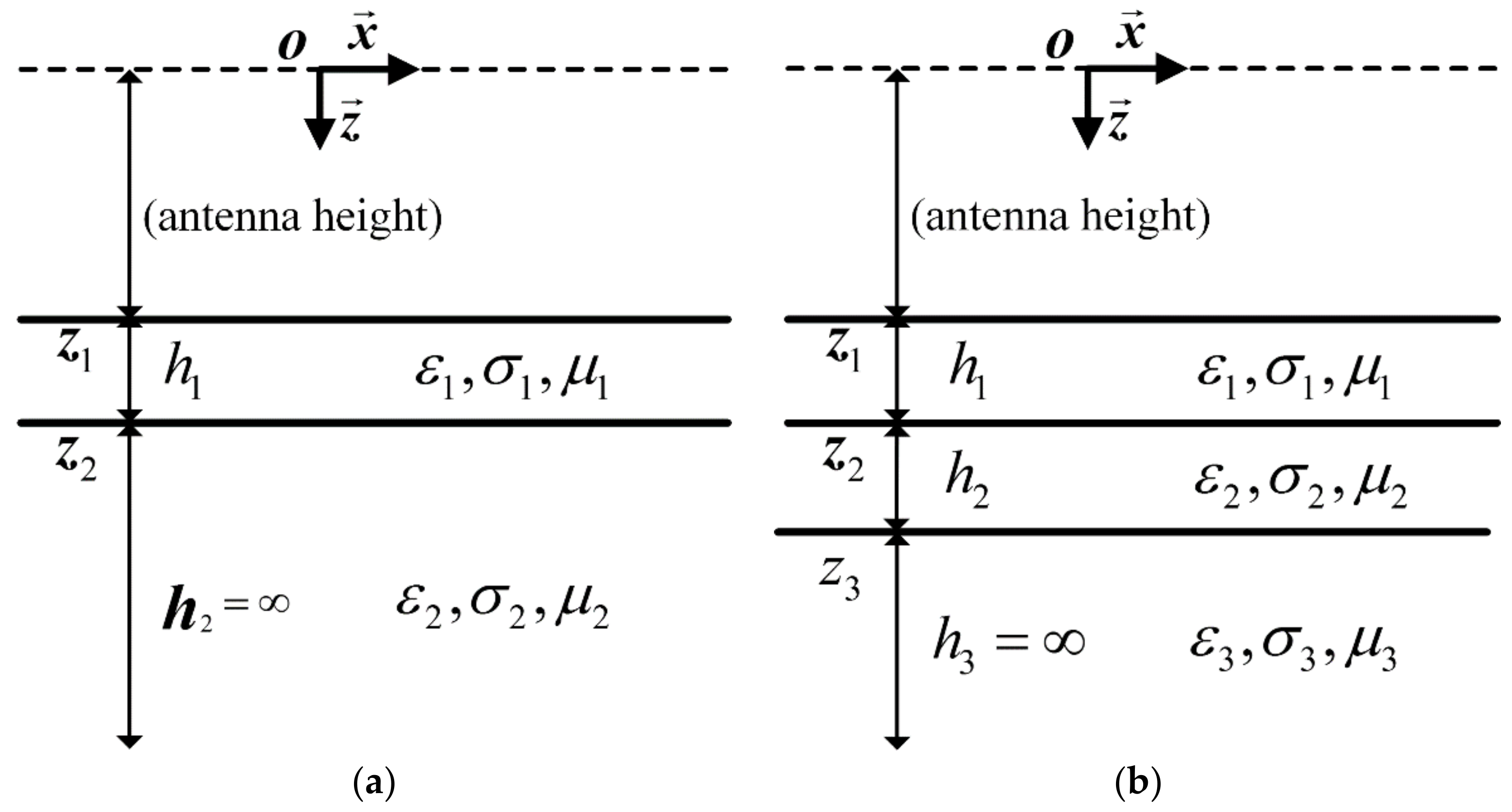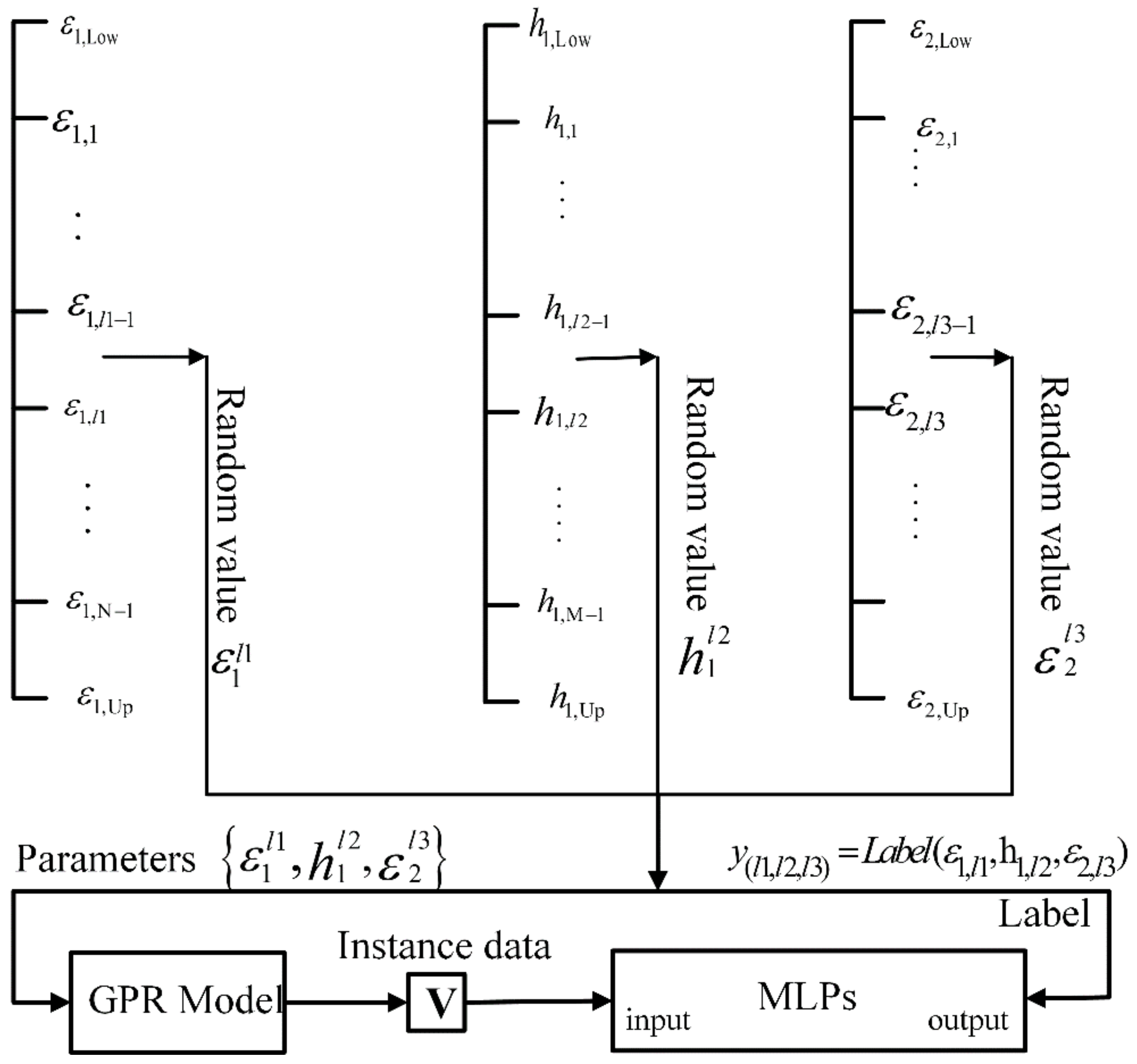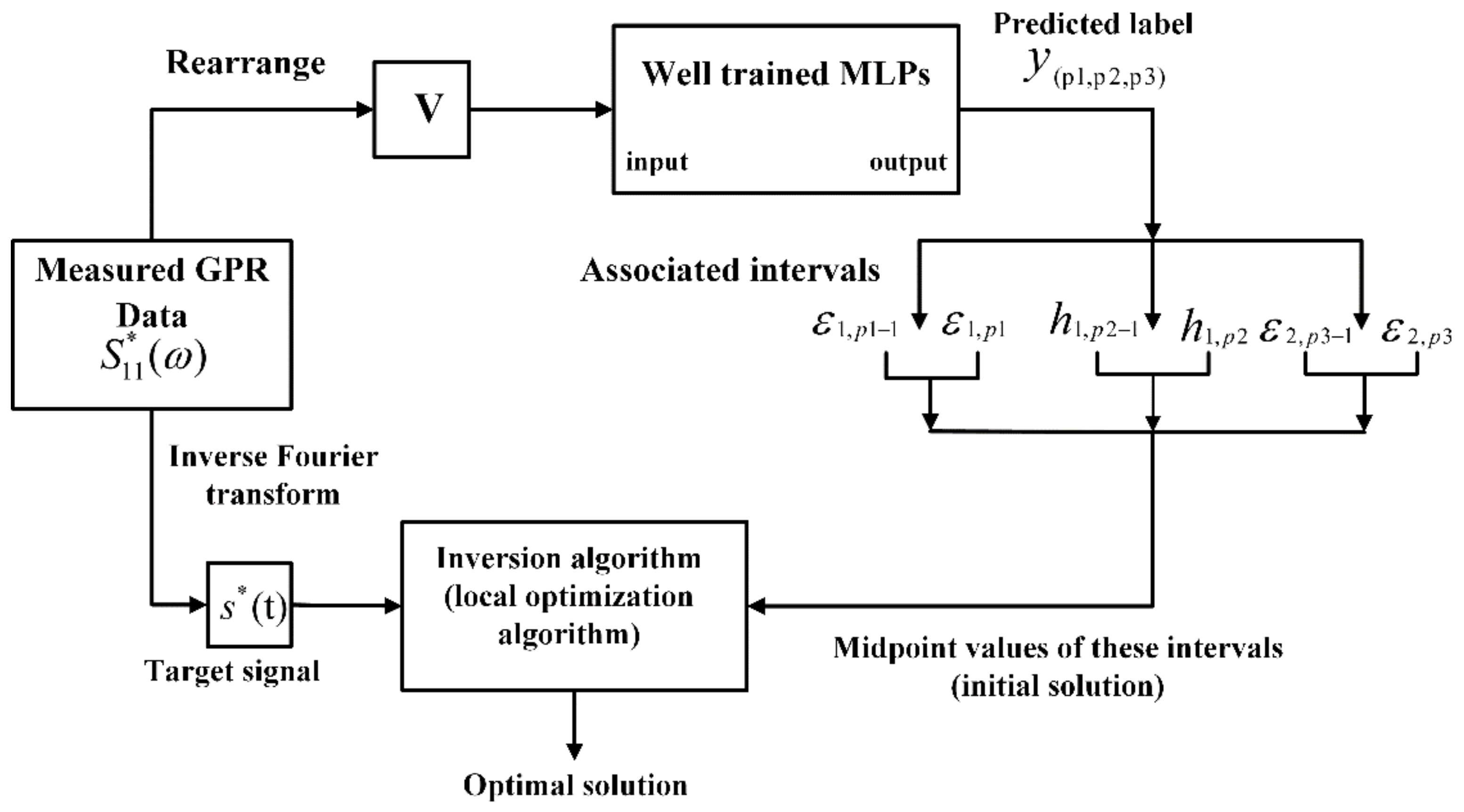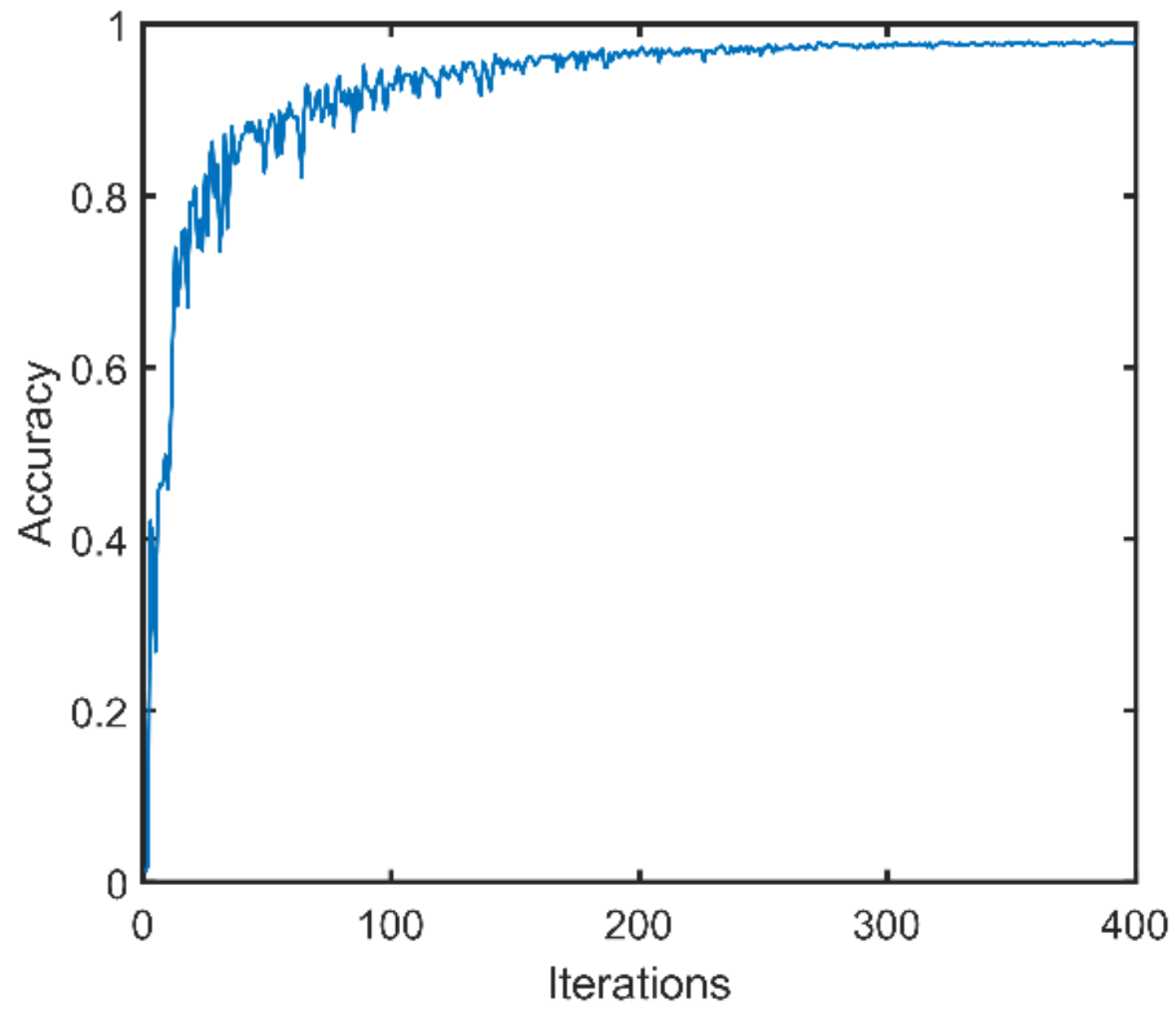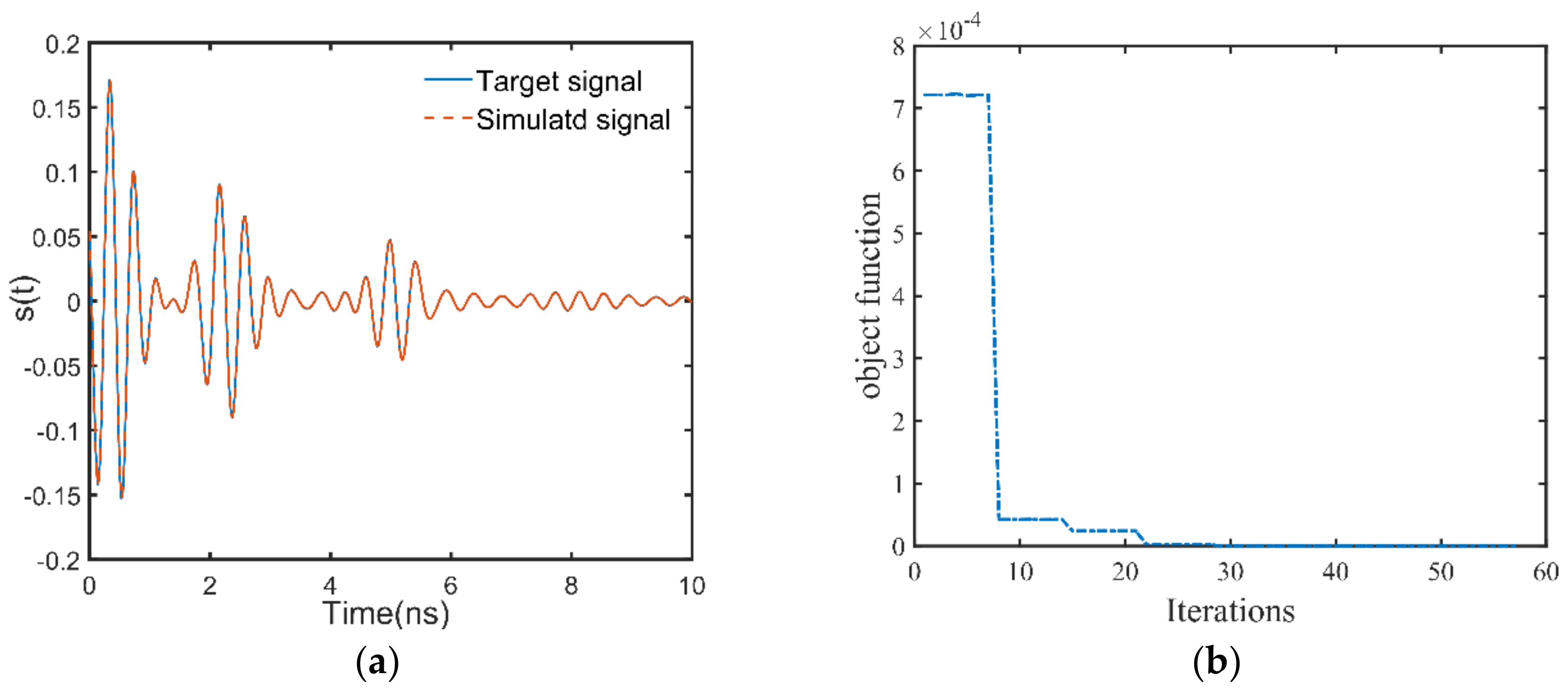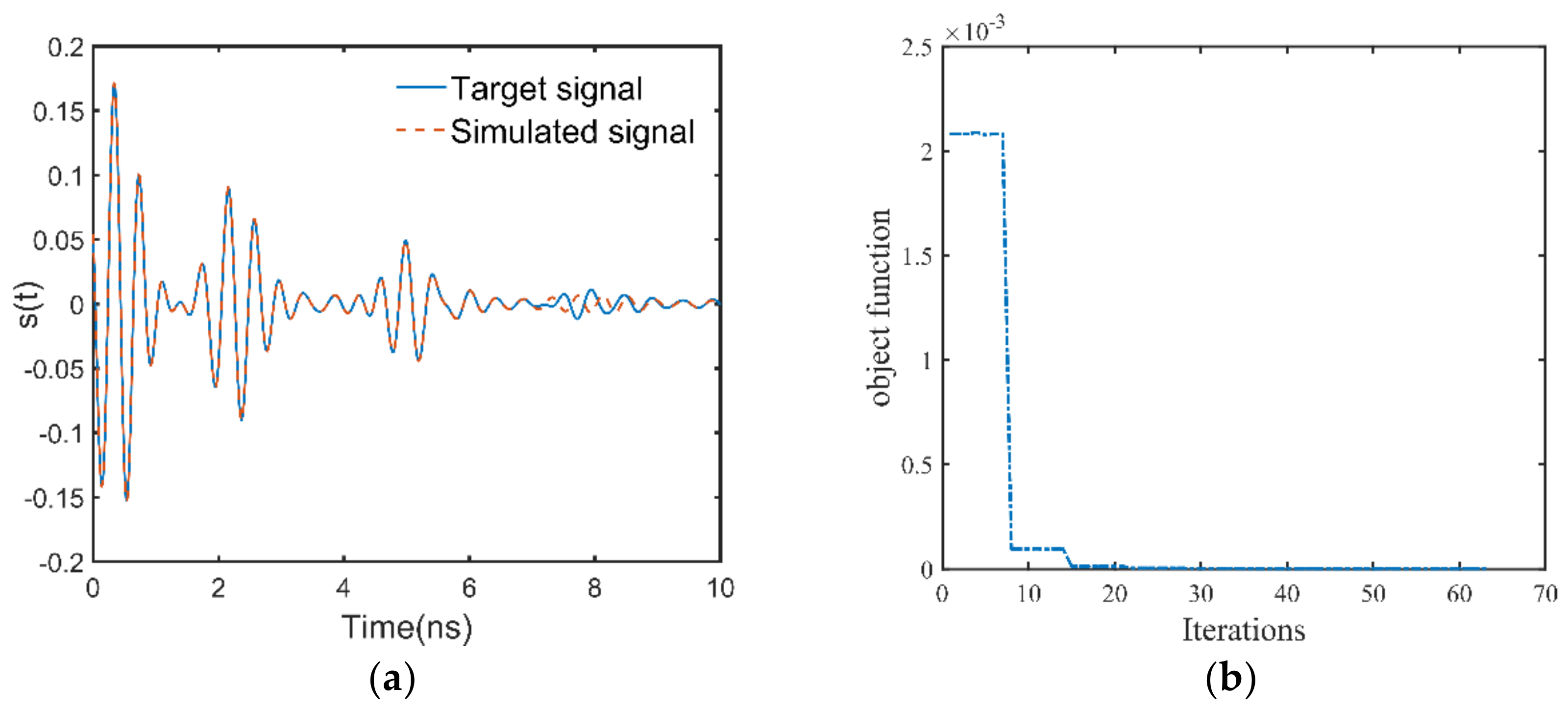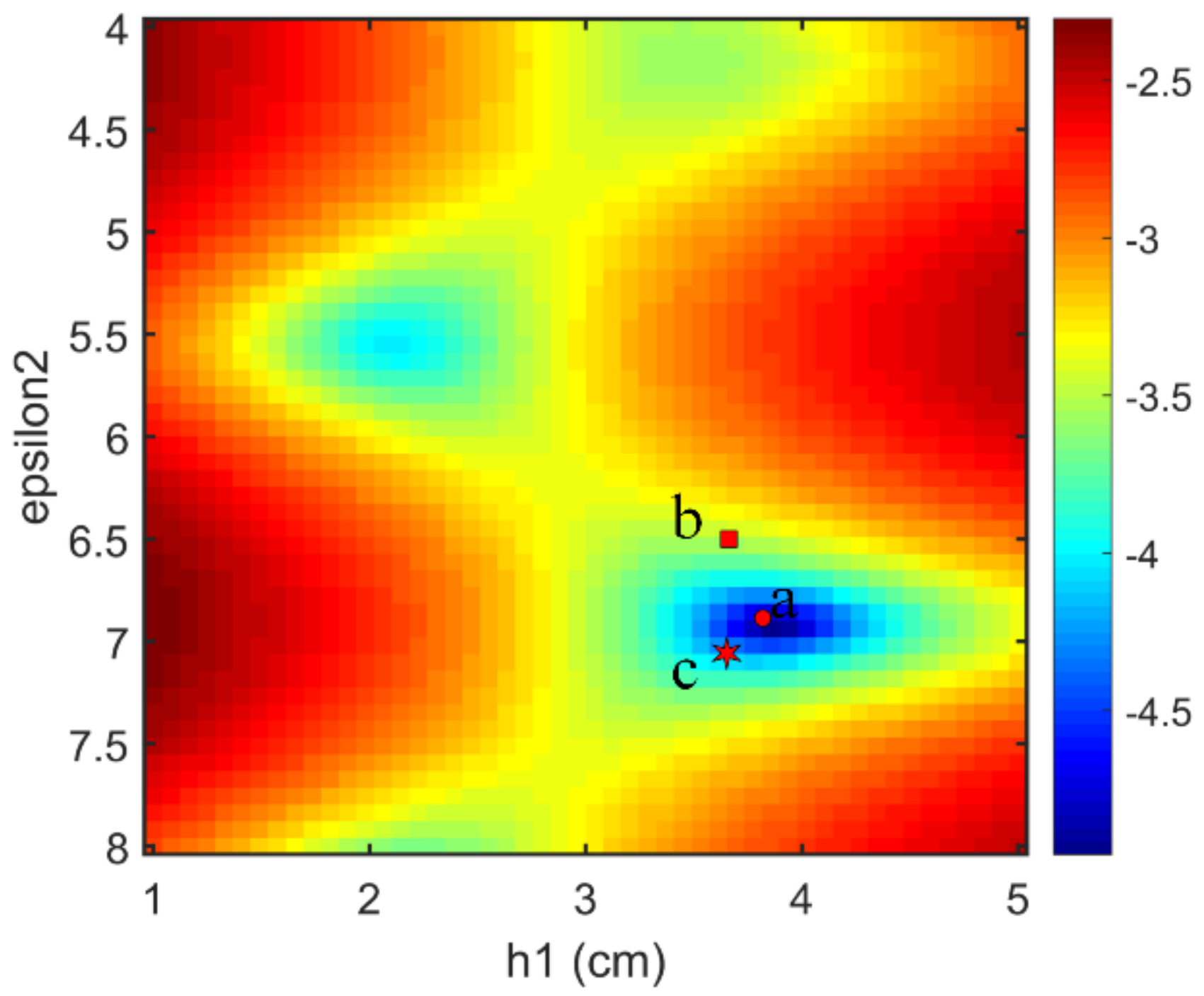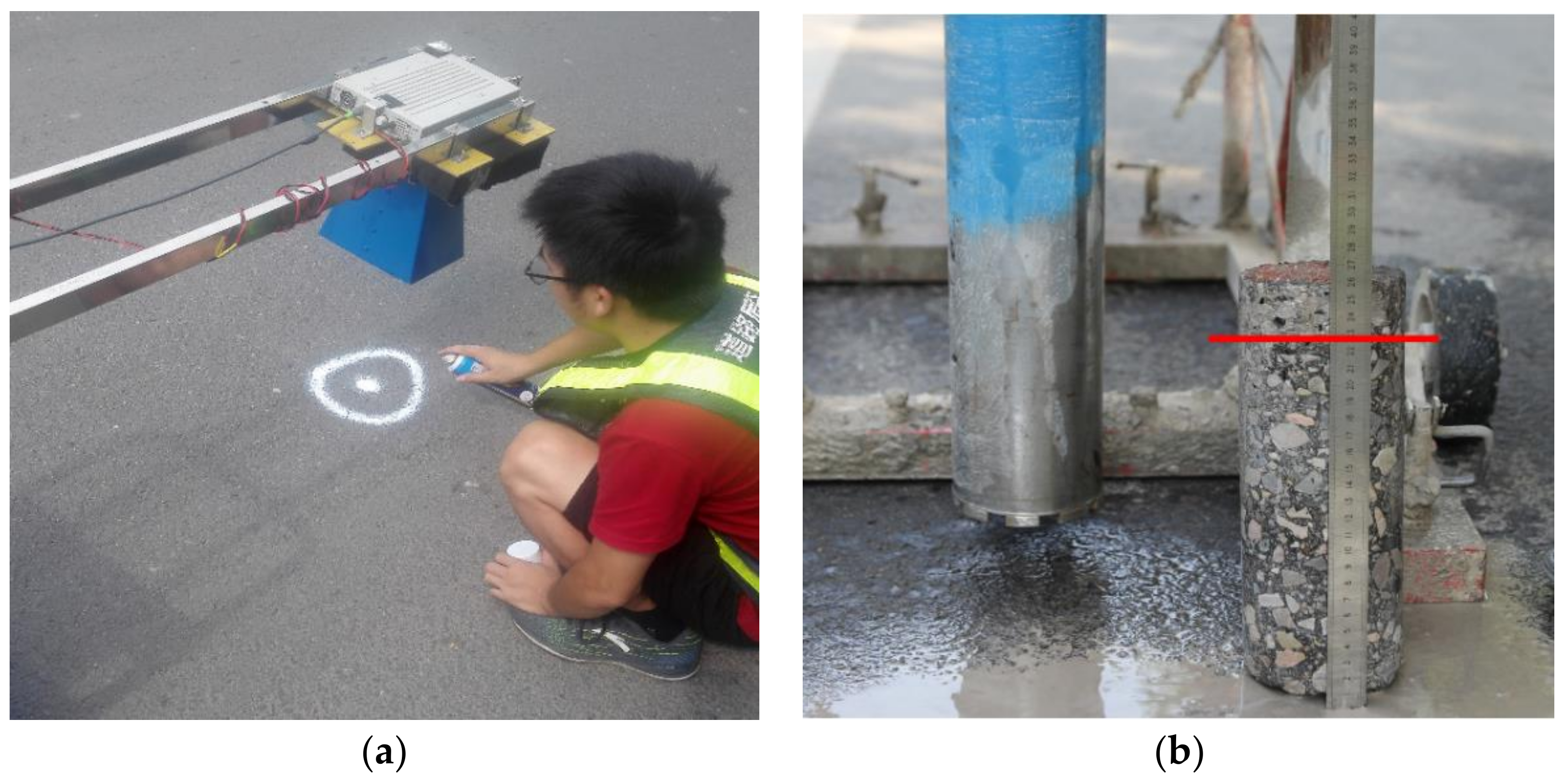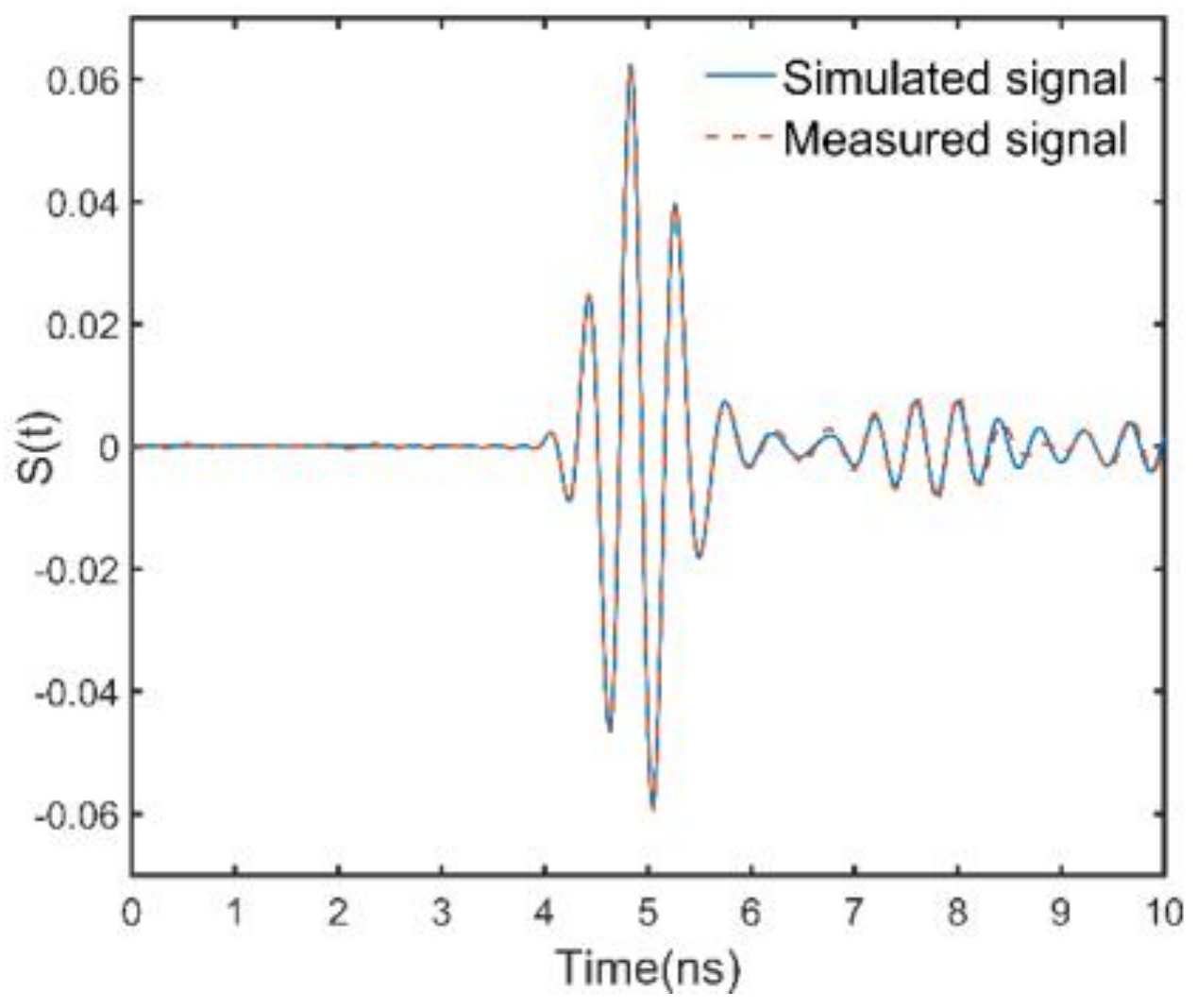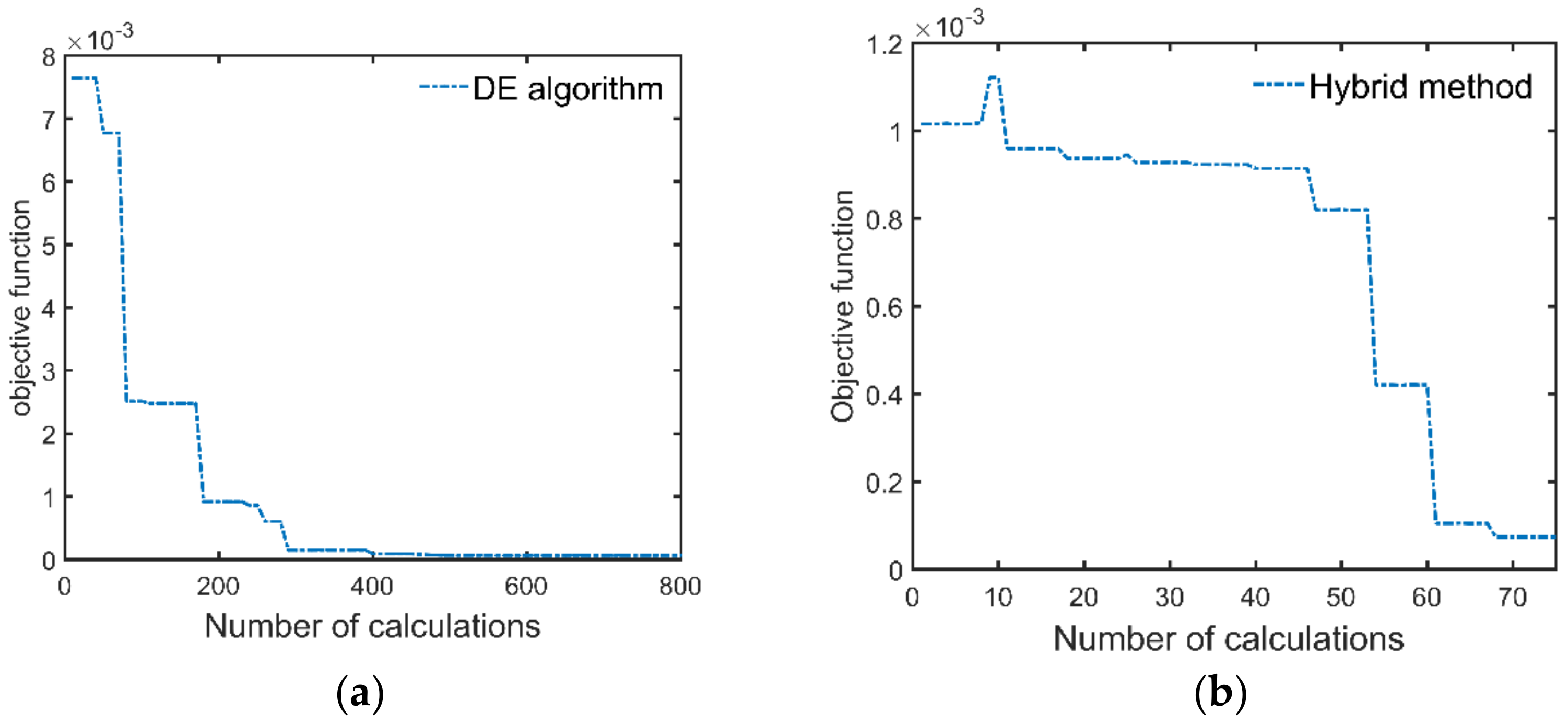3.1. Numerical Experiment of the Hybrid Method
This section aims at illustrating that the proposed hybrid method can improve the efficiency of the full-waveform inversion. First of all, a mono-static GPR composed of a homemade horn antenna and a portable vector network analyzer (VNA) is modeled with the method introduced in
Section 2.1. The portable VNA model is produced by COPPER MOUNTAIN TECHNOLOGIES (S5048) [
25], and its operating frequency ranges from 20 kHz to 4.8 GHz. The dimensions of the homemade horn antenna are 22 cm length and 16 cm
30 cm aperture area. Its nominal frequency is 0.75–4.5 GHz, and its isotropic gain ranges from 6–14 dBi. In the experiment, the mono-static GPR operates on the frequency range from 0.9 GHz to 3.5 GHz with 108 frequency points. To calibrate the mono-static GPR model, measurements were performed with antenna at 41 different heights from 0.4 m to 0.6 m over a 2.5 m
2.5 m copper sheet. During the preparation of the training data, white noise is added to the simulated GPR data with a moderate signal to noise ratio (SNR) i.e., 20 dB. The antenna height is in the range from 0.45 m to 0.47 m. The thickness of the first layer is within the range from 2 cm to 5 cm, the relative permittivity of the first layer is within the range from 4 to 7, and the relative permittivity of the second layer is within the range from 5 to 8. The dielectric constant of the second layer is set larger than that of the first layer because the second layer has a larger degree of compaction, which is proportional to the dielectric constant [
26]. According to the descriptions in
Section 2.4, the thickness range of the first layer (
) is divided into
,
,
,
,
,
; the permittivity range of the first layer (
) is divided into
,
,
,
,
; and the permittivity range of the second layer (
) is divided into
,
,
,
,
. In particular, for the three-layer pavement model, the thickness of the second layer is set to a random value between 8 cm and 12 cm, and the relative permittivity of the third layer is fixed at 4. It can be seen that the permittivity ranges of the first layer and the second layer are partially overlapped. In order to avoid insignificant parameter combinations (i.e., the permittivity of the first layer and second layer are equal), the following conditions must be met when combining these parameter intervals:
where,
l1,
l2,
l3 are respectively the index numbers of the intervals in original ranges, and
is the number of the class. There are a total of 90 classes. For each class, 150 GPR data are respectively simulated by using the two-layer pavement models and the three-layer pavement models. Therefore, there are a total of 27,000 training data. To validate the classification performance of the MLPs, fifteen percent of the training data is used as the test set, and the test set would not be used to train the MLPs. In the numerical experiment, MLPs with two hidden layers are trained. There are 200 and 150 neurons in the two hidden layers, respectively. The number of neurons in the input layer and the output layer is respectively 216 and 90. The learning rate is in the form of exponential decay, with a base of 0.9 and an attenuation factor of 0.99. The training process of the MLPs is finished in the framework of TensorFlow. In the experiment, the MLPs are trained for 400 iterations. After each iteration, the trained MLPs are applied to the test data, and the classification accuracy is plotted versus the number of iterations in
Figure 5. It can be found that the maximum classification accuracy is 98.6%, which means that the well trained MLPs can accurately classify the test data into corresponding classes according to the preset rule with a significantly high probability.
To verify the performance of the hybrid method at the respect of full-waveform inversion, three GPR data are selected from the test set to perform full-waveform inversion, and two of which are correctly classified and one is misclassified. The two correctly classified GPR signals are respectively simulated by the two-layer pavement model and the three-layer pavement model. Since only the thickness of the first layer and the permittivities of the first two layers are estimated, the signals before 6.5 ns are matched when performing the full-waveform inversion. The correctly classified GPR data generated by the two-layer pavement model has the simulation parameter combination of
,
,
, and the corresponding class number of 1. According to the preset rule, the initial solution of the full-waveform inversion is
,
,
. In addition, the antenna height is 0.462 m, which is considered as known in the full-waveform inversion. The antenna height is considered as known because it could be determined independently using other methods such as laser measurements in practical applications [
8]. For the full-waveform inversion, the Levenberg-Marquardt (LM) algorithm is set with a maximum number of iterations of 70 and a step tolerance of
. The inversion results are
,
,
, which agree well with the simulation parameter combination.
Figure 6a shows the GPR data simulated by the inversion results and the target signal, and significant agreement can be seen between them.
Figure 6b shows the trajectory of the objective function during the inversion process. It can be seen that the algorithm converges after only thirty iterations. According to the previous study on the topology structure of the inversion objective function [
8], the function gradient is small in some ranges of the inversion parameters and large in other ranges. Therefore, in the inversion process, the objective function will show a tendency that it sometimes changes slowly and sometimes changes dramatically (
Figure 6b).
The correctly classified GPR data generated by the three-layer pavement model has the simulation parameter combination of
,
,
,
,
, and the corresponding class number of 53. Since only the thickness of the first layer and the permittivities of the first two layers are estimated, the time range for the inversion is within 6.5 ns, and the initial solution of the full-waveform inversion is
,
,
. The antenna height is 0.460 m, and the configuration of the LM algorithm remains the same as before. The inversion results are
,
,
, which agree well with the simulation parameters of the target signal.
Figure 7a shows the GPR signal simulated by the inversion results and the target signal, and significant agreement can be seen between them within 6.5 ns.
Figure 7b shows the trajectory of the objective function during the inversion process. It can be found that the algorithm also converges after about thirty iterations. For the misclassified GPR data, it has the simulation parameter combination of
,
,
,
,
, and the corresponding class number of 64. However, it is misclassified into class 58. According to the preset rule, the initial solution derived from the misclassification result is
,
,
. Then, the initial solution is used for the full-waveform inversion, and the trajectory of the objective function during the inversion process is plotted in
Figure 8. If this GPR data is correctly classified, its initial solution would be
,
,
according to the preset rule. This initial solution deduced by the correct classification result is also used for full-waveform inversion, and the trajectory of the objective function during the inversion process is also plotted in
Figure 8. It can be seen from
Figure 8 that the LM algorithm converges faster when the initial solution derived by the correct classification result is used. Nevertheless, the LM algorithm converges fast for both of the two initial solutions. The inversion results for both the two initial solutions are
,
,
, which agree well with the simulation parameters of the target signal. In order to understand the phenomenon in
Figure 8, the 2-D response surface topography of the objective function is computed. The objective function is computed with
and
as input. The value of
and the antenna height are considered as known. The misclassified test GPR data is the target signal of inversion. To better highlight the topography, the objective function values are express in a logarithmic scale (
Figure 9).
Figure 9 shows that several local minima are distributed around the global minimum, which is why the full-waveform inversion of the GPR data in the conventional methods require global optimization algorithms. The global minimum is in the center of a basin with a radius of 0.5 along the
direction and a radius of 1 cm along the
direction. These radii are greater than half the lengths of the corresponding parameter intervals. This fact indicates that if a GPR data is correctly classified by the MLPs, the corresponding initial solution falls into the basin centered on the global optimal solution. Therefore, the gradient-based local optimization algorithm LM can quickly search from the initial solution to the global optimal solution. Since the MLPs extract a set of features from the training GPR data for each class, a newly input GPR signal is predicted to a class based on the degree of the similarity to these features. Because the features of the GPR data are determined by the characteristic parameters of the pavement, when a parameter of the GPR data is close to the parameter interval boundary, it may be misclassified to the nearest neighbor interval with a small probability. In this case, the distance between the initial solution and the global optimal solution would be slightly larger than the length of the half interval. Nevertheless, since the length of the parameter interval is relatively small, the initial solution of the misclassified GPR data will still falls within the basin centered on the global optimal solution. For example, the global optimal solution of the misclassified test GPR data is
, and the initial solution derived from the misclassification result is
. It can be seen from
Figure 9 that the initial solution derived from the misclassification result still falls in the basin centered on the global optimal solution. If the above test data is correctly classified according to the experimental settings, the initial solution would be
. The distance between the initial solution derived from the misclassification result and the global optimal solution in the
direction is 0.35, and the distance between the initial solution derived from the correct classification result and the global optimal solution in the
direction is 0.25. Consequently, the misclassification result increases the distance between the initial solution and the optimal solution by 40%, and also increases the number of iterations of the inversion process.
The full-waveform inversion of these three test data have also been performed by conventional DE algorithm, which is the state-of-the-art method addressing the “thin layer problem”. The parameter search is performed on the corresponding entire range (
,
,
), the number of the population is 10, and the maximum generation is 80 [
10].
Table 1 shows the number of calculations of the objective function to find the global optimal solution. It can be seen from
Table 1 that since the initial solution provided by the MLPs is close to the optimal solution, the optimal solution can be found after a small number of searches. The DE algorithm encounters many local minima in the inversion process, so a lot of trials are needed to find the global optimal value. Therefore, the hybrid method can improve the efficiency of the full waveform inversion.
3.3. The Influence of Layer Thickness and Permittivity on results
As shown by the results in the
Section 3.1, the performance of the proposed hybrid method depends on whether the MLPs can accurately classify the input GPR data. When the classification result of the MLPs is accurate, the initial solution derived from the classification result will be in the basin centered on the global optimal solution. In this case, the global optimal solution can be quickly searched by using the gradient-based local optimization algorithm. If GPR signal has a corresponding layer thickness and permittivity that exceeds the ranges of parameters used to train the MLPs, the MLPs cannot accurately classify the GPR signal. Therefore, the performance of the hybrid method will be affected. In the numerical experiment, the ranges of the layer thickness and permittivities used to train the MLPs are respectively
,
,
. We use two parameter combinations
,
to simulate GPR data. For
, the value of
exceeds 15% of the specified range, For
, the value of
exceeds 30% of the specified range. The GPR signals simulated by
and
are sent to the hybrid method.
Table 2 shows the inversion results of these two GPR signals.
It can be seen from
Table 2 that since the parameters of
and
are beyond the specified parameter ranges to a large extent (more than 15%), the initial solution derived from the classification result of MLPs is far from the global optimal solution, so the estimation errors of the hybrid method are great. In order to accurately invert the parameters of
and
, we adjust the training parameter ranges of the MLPs to
,
,
. These parameter ranges are divided into small intervals according to the same operations in
Section 3.1. The interval lengths of
and
are 0.6, and the interval length of
is 0.5 cm. The MLPs uses the 27,000 GPR data generated over these parameter intervals for training, with a highest classification of 98.7%. The GPR signals simulated by
and
are again sent to the hybrid method.
Table 3 shows the inversion results of
and
after the training parameter ranges adjustment. It can be seen from the results in
Table 3 that when the ranges of the training parameters of the MLPs is adjusted to cover the parameters of
and
, the parameters of
and
can be accurately inverted using the hybrid method. Combining the results of
Table 2 and
Table 3, it can be seen that the minimum layer thickness and permittivity that can be successfully detected by the hybrid method depend on the ranges of training parameters of the MLPs. In pavement inspection, the training parameter ranges of MLPs can be set to cover the possible properties values, so the hybrid method will have good performance.
Just like the hybrid method, the state-of-the-art full-waveform inversion method based on DE algorithm is also affected by the ranges of search parameters set. We compared the performance of the two methods in case where the characteristics corresponding to the GPR data are slightly outside the training parameter ranges of the hybrid method and the parameter search ranges of the DE inversion method, for example, within 5%. We used other two parameter combinations
and
to simulate GPR data, and the training parameter ranges of the hybrid method and parameter search ranges of the DE method are same (
,
,
). For
and
, the values of
and
exceed 5% of the specified ranges.
Table 4 shows the inversion results of the hybrid method and the DE inversion method for
and
in case where the parameters values are slightly outside the specified ranges. The results show that the hybrid method can accurately invert these parameters, and the DE inversion method has a maximum thickness estimation error of 0.12 cm and permittivity estimation error of 0.43.

